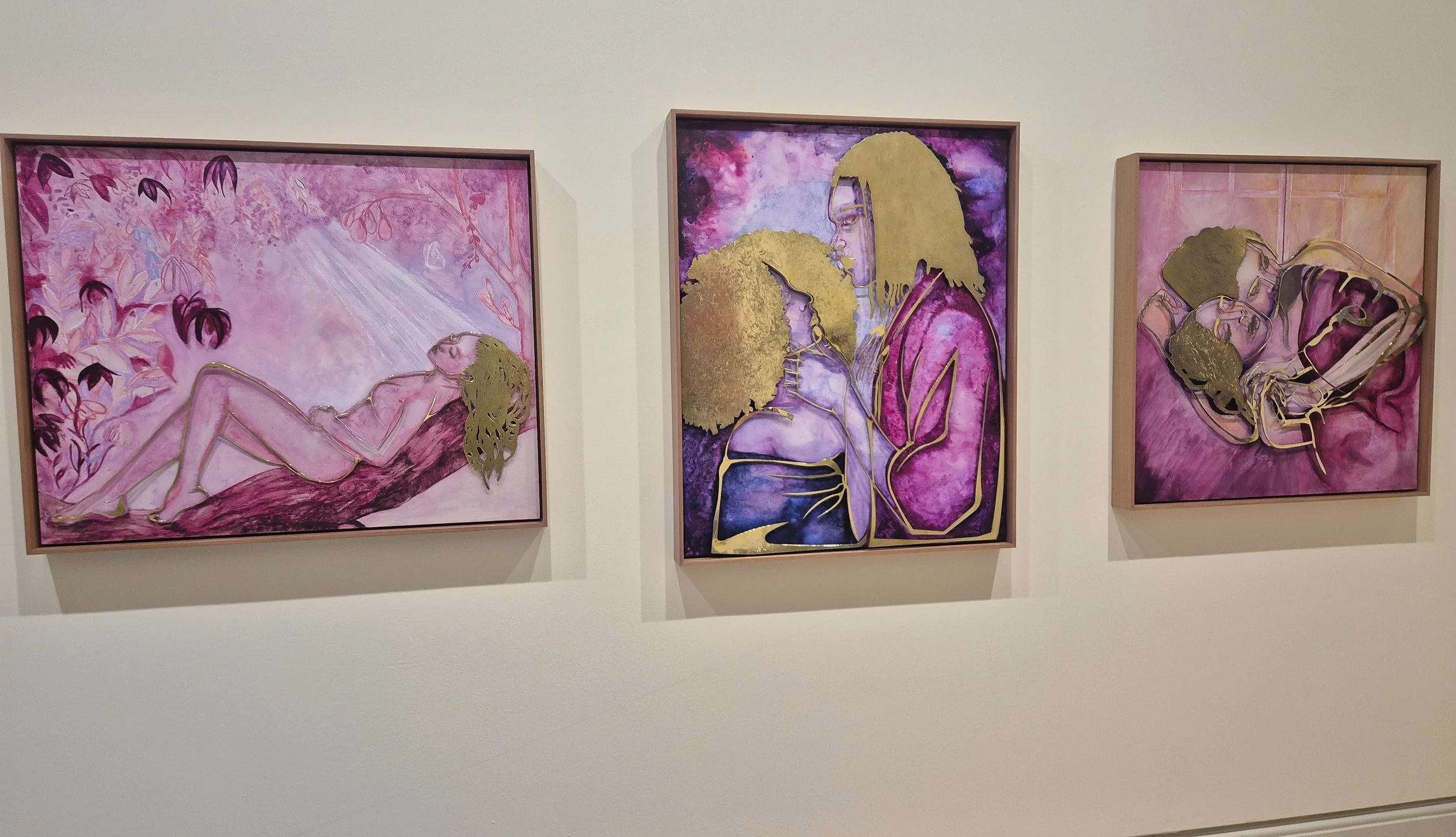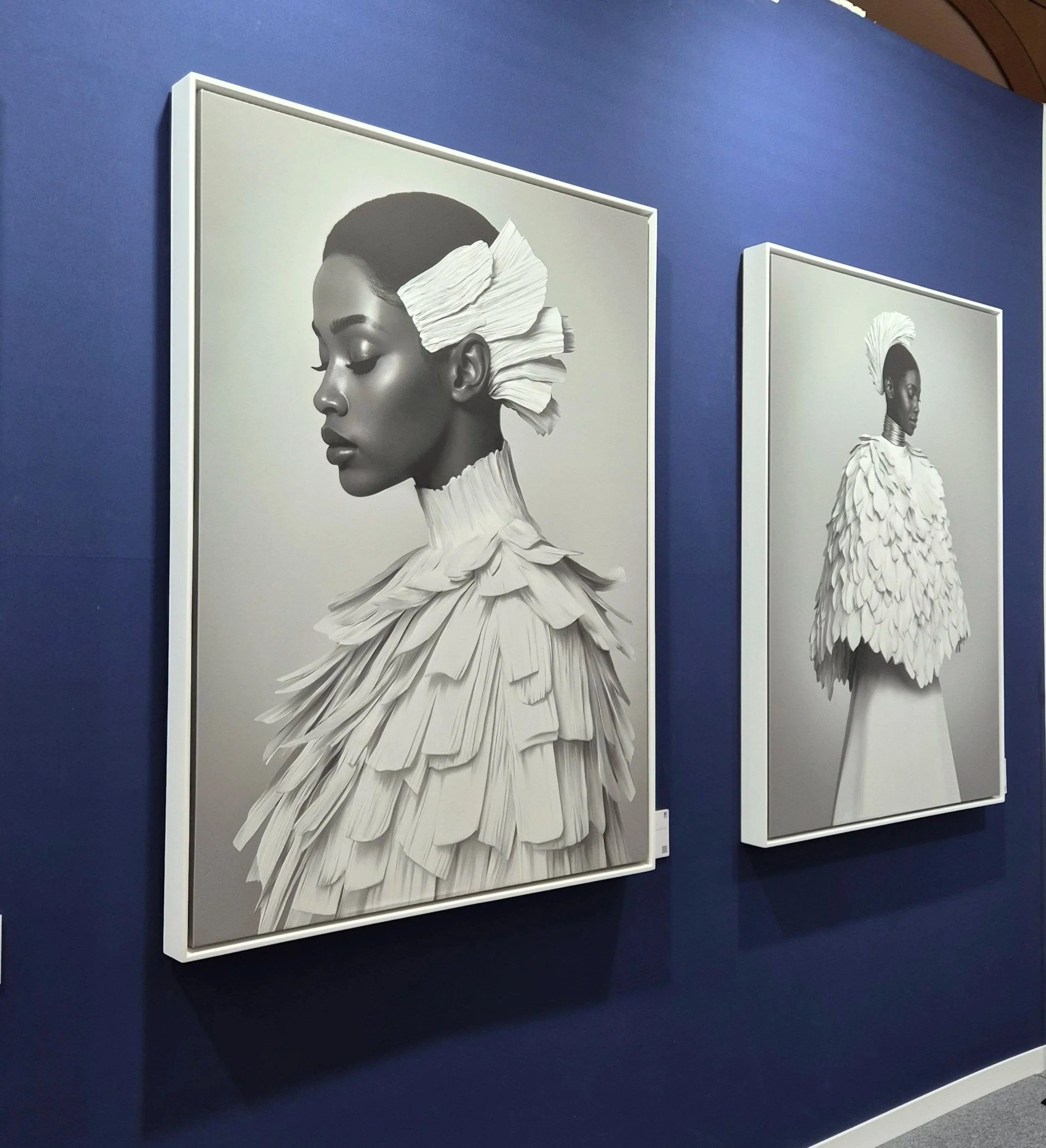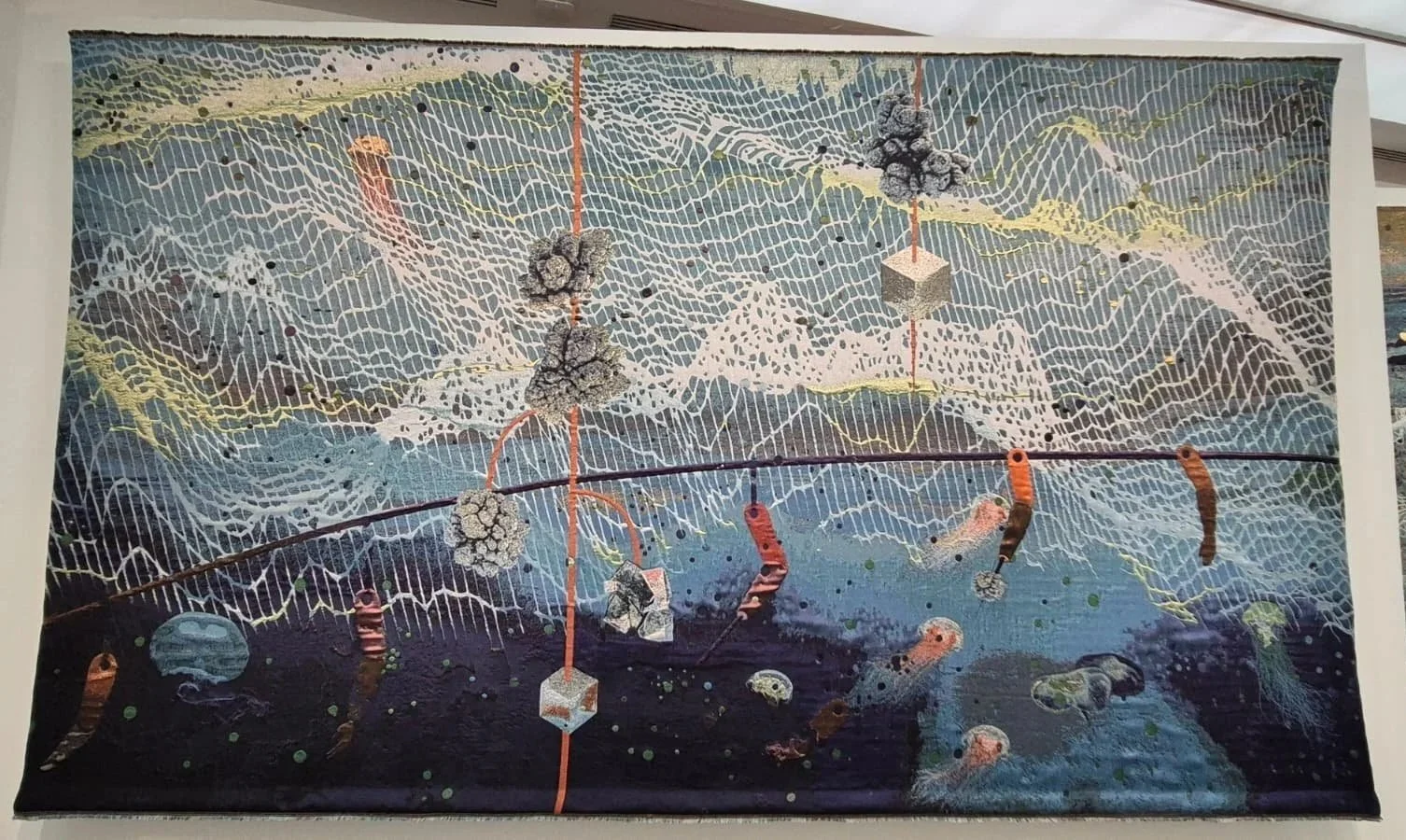Frieze and Paris Art Week: Two Cities in Conversation
October unfolded as a month of intensity and discovery. Right after Frieze Week in London, I boarded a train to Paris Art Week, tracing a thread that connected two cities alive with contemporary art, dialogue, and new encounters.
LONDON ART WEEK
1-54 ART FAIR
In London, 1-54 Contemporary African Art Fair once again delivered a rich and layered edition. I had the privilege of exhibiting with Roisin Jones with 1897 Gallery, alongside Yanma Fofana and Ayoola Gbolahan — a presentation that captured dialogue across mediums, materialities, and sensibilities. Roisin Jones presented stunning selenite pieces alongside a continuation of her work with brass silhouettes. Her series ‘Love Learns to Breathe’ examines Black love, self-love, and intimacy as acts of liberation—where love becomes both resistance and renewal. Presenting her work at the fair was a milestone and a confirmation of her incredible talent !
Among the highlights of the art fair, I was pleased to discover Egytian artist Reem Osama with her delicate, polished bronze sculptures with Gallery Misr. They stood out for their quiet poise and tactile depth, the body is represented with geometric precision and organic rhythm, drawing on ancient Egyptian form while evoking strength and stillness.
While strolling throught the building, I was drawn to the shimmering work of South African artist Sahlah Davids. Her works stitch together textiles, upholstery and needlework—traditions passed down through her family’s seamstress heritage—into mixed-media forms that probe the relationship between religion, politics and material memory.
At October Gallery, Zana Masombuka expanded her visual language with a new technique that integrates beads directly into her photographic prints. This approach, increasingly seen among emerging artists exploring material hybridity, adds texture, dimension, and cultural resonance to her imagery. Masombuka works fluidly across photography, installation, and performance, merging digital and tactile media to explore identity, ritual, and transformation within her traditions and global modernity. Her beaded portraits, both structural and sensorial, embody an ongoing dialogue between heritage and contemporary expression.
Nigerian-based painter Afeez Onakoya presented charcoal-and-acrylic silhouettes with Oda Art, his work radiated strength and emotion, I loved the mix of charcoal surrouanded by bright acrylic block colour to make the grey silouhettes contrast and give them a dramatic stance.. A graduate of Yaba College of Education, his works reflect a deep engagement with figurative art, exploring human life, resilience and aspiration through the minimal gesture of charcoal on canvas.
Meanwhile, at Filafriques, South African artist Reggie Khumalo draw on the spirit of Ubuntu and translating it into vibrant intimate portraits that affirm storytelling and the elegance of the feminine. He continues his practice of integrating textiles into his work cascading out of the picture onto the floor, inviting the viewer into his work, inviting the viewer to interact and find connections.
The city’s art calendar was saturated with events, each one testing the boundaries of what contemporary African and diasporic art can articulate. Among the many activities I foudn the time to do, a visit to Alvaro Barrington’s studio-in-progress offered a rare insight into process — raw, generous, and in formation. We saw the premise of new spaces building, studio that will allow community and collective working.
It followed with a visit to Messum and had the priviedge to hear about the exhibition from the curator’s tour, Lisa Anderson. Highlights on this show for me was British-Jamaican artist Sonia Elizabeth Barrett who offered precise — Barrett’s sculptural practice draws on furniture, textiles to interrogate Black subjectivity, material histories.
Minor Attractions’ incredible event “Fela to the Future” created a charged atmosphere, with some screening of films at the begining, Fela to the Future at Minor Attractions centred on a discussion with Lemi Ghariokwu, Rikki Stein, and Dele Sosimi about Fela Kuti’s enduring influence across music, politics, and visual culture—framing him as a revolutionary thinker whose legacy continues to shape contemporary diasporic art and activism. This moment felt like history unfolding in real time.
At Hope 93 Gallery the exhibition marked one year since its opening and celebrated the work of Misan Harriman, whose photographer-activist practice continues to bridge representation, social change and craft, an artist I am discovering far too late.
Other remarkable presentations included Bunmi Agusto’s deeply spiritual mixed-media installation at Tiwani Contemporary — Agusto builds fantasy-worlds through painting, drawing and writing, exploring hybridity and the metaphor of the ‘alien’ within cultural theory. She presented paintings of vibrant colours and a short video using her work which was a surprising new aspect of her practice.
Also presenting at Tiwani and from Nigeria-UK, Ugonna Hosten drew me into her mythic visual narratives of divine femininity; a multi-disciplinary artist working across drawing, and incredible assemblage to build alternate worlds of story and self, sometime mixing the scultpural with the drawings and frames.
PARIS ART WEEK
Leaving London’s charged atmosphere behind, Paris offered a different kind of rhythm — slower, reflective, yet equally rich in conversation. I began the week with an illuminating talk hosted by Detroit Art Salon, an independent platform connecting artists, curators, and collectors through intimate discussions. The exchange focused on African art and Detroit’s evolving role within the US cultural landscape gathered artists Conrad and Kesswa, founder of 1-54 Touria Elglaoui, and moderator and curator — a perspective I found refreshing and unexpected.
AKAA ART FAIR
My first stop was AKAA (Also Known As Africa), Paris’s leading fair dedicated to contemporary art from Africa and its diaspora. Experiencing it for the first time was a welcome surprise. I was particularly drawn to Serge Mouangue’s collaboration with Space Un Gallery, where masks and textiles danced together, merging Japanese sensibility with African form — a poetic dialogue of dual heritage.
Art Melanated offered another moment of resonance through Jennia Aponte’s portraits of young girls reimagined in a steampunk aesthetic, depicting them as resilient inventors. It was equally rewarding to reconnect with the Montresso Art Foundation, first encountered during 1-54 Marrakech earlier this year, and to encounter familiar artists in a new context.
A significant discovery was Maison Gaston – Maison d’Art Créole, a nomadic gallery founded by Christelle Clairville. Its mission to foreground artists from the French-Caribbean and its diasporas, while centring Creole identity, hybridity, and island culture, struck a deep chord. Seeing Gwladys Gambie’s work there felt like a full-circle moment — her practice evolving yet st ill rooted in the poetics of body, territory, and inheritance.
Filafriques presented a refined curatorial voice, showing the majestic photography of Gavin Goodman — compositions that were both measured and sensorial. The gallery’s commitment to African and diaspora artists across continents reflects a necessary continuity in today’s art landscape.
ART BASEL
At Paris+ par Art Basel, my attention gravitated toward Bianca Bondi, whose alchemical practice transforms natural materials into mutable, time-based environments; Hector Hippolyte, the Haitian modernist who brought Vodou spirituality into the canon of modern art; and Xei Lei, whose language merges classical and contemporary expression, letting light sculpt the silhouettes of his characters with quiet cinematic power. I found each painting have such a powerful and warming feeling.
Although Hector Hippolyte had a short yet intense public career, he left a significant mark on Haitian art. A third-generation Vodou priest (houngan), Hippolyte painted without formal training and was known to work with whatever materials were available, including chicken feathers on cardboard. His talent was later recognised by writer and politician Philippe Thoby-Marcelin, who brought him to Port-au-Prince and effectively launched his career. In 1945, during a visit to Haiti, André Breton — the French poet and leader of the Surrealist movement — discovered Hippolyte’s work and introduced him to Western audiences, contributing to his international reputation. Much of Hippolyte’s work is deeply inspired by Vodou spirituality, depicting divinities (loa), ceremonies, and rituals. He also blended Vodou and Christian iconography, and occasionally portrayed historical figures, such as Toussaint Louverture. The Gallery of Everything, which has exhibited his work, describes him as “the spiritual father of the Haitian art movement.”
Another essential visit was to the Musée d’Art Moderne de Paris, where Otobong Nkanga’s solo exhibition examined memory, resource, and the politics of landscape with characteristic precision, an arresting retrospective. The exhibition spans her early work to her most recent pieces, bringing together sculpture, tapestry, installation, prints, photography, mixed media, and performance. It is her first major solo show in Paris. Nkanga’s work examines land, ecology, and extraction, grounded in histories of colonialism and power.
Materiality plays a central role in her practice, a detail reflected in a wider shift in contemporary art toward forms that move beyond the flat surface and invite visual, physical, and even spiritual engagement from the audience.
For me, the standout works are her monumental tapestries depicting a hortizontal landscape from oceanic to forest. Their vibrant colours evoke memory, connection, formally stiched together horizonatally for the kunsthaus bregenz. Their vibrant colours evoke memory and the Middle Passage linking the ocean’s depths to forested landscapes and how each environement is closey linked together ecologically. Nkanga highlights the ecological truth that what happens in the sea inevitably affects the land. The exhibition also foregrounds mining and resource exploitation, a pressing issue across many regions in Africa. For Nkanga, water, soil, and human systems are deeply interconnected.
Her Unearthed tapestry series deepens these concerns, mapping landscapes marked by extraction and revealing how the ground itself holds memory, trauma, and resilience.
Selected for the Prix Marcel Duchamp, Bianca Bondi creates immersive environments shaped by processes of transformation, where ecosystems appear between decay and renewal. Her practice draws on chemical reactions to generate delicate formations and shifting surfaces, producing an atmosphere of continual mutation. Beyond visual impact, her installations seek a deeper, sensorial experience.
Bondi frequently incorporates ecological elements—plants hanging from walls, moss spreading across the floor, or organic growth emerging from unexpected places. She merges her interests in ecology and occult sciences, weaving together the spiritual and the scientific. Salt, a recurring material in her work, carries connotations of purification and protection.
Her installation Silent House immerses the viewer in a familiar yet disquieting domestic setting, where everyday objects such as a bed, wardrobe, and chair are crystallised in salt. Informed by Jungian theory, the work transforms the home into an inner psychic landscape in which each object becomes a vessel for memory, latent energy, and symbolic meaning.
This past month , and mainly both art weeks offered a reminder of how artistic geographies overlap and speak to each other — London’s pulse of immediacy countered by Paris’s reflective composure. Together, they marked not only a season of fairs but the beginning of a broader conversation about movement, identity, and the spaces where art can meet across worlds.
This trip confirmed my next step in my life and career….



































